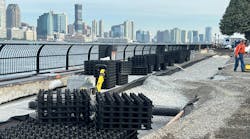StormStore Aims to Incentivize Natural Solutions
About the author:
Katie Johns is the managing editor of Storm Water Solutions. She can be reached at [email protected].
When the Metropolitan Water Reclamation District of Greater Chicago updated the Watershed Management Ordinance to require all new site developments in Cook County to manage storm water runoff, the Nature Conservancy and Metropolitan Planning Council created a program called StormStore.
StormStore aims to help developers both efficiently and economically manage storm water and incentivize the use of natural solutions. The program allows community organizations and business to sell their extra storm water capacity to developers, which is part of a credit-trading system.
Below, Ryan Wilson, manager of water resources with the Metropolitan Planning Council, and Jen Jenkins, natural infrastructure project manager with The Nature Conservancy, talk with SWS Managing Editor Katie Johns about the program and its benefits.
Katie Johns: Can you guys give me an overview of StormStore and how it came to be?
Ryan Wilson: I worked with the Metropolitan Planning Council ...and for the last probably 14 years, we've been working on water resources and about eight or nine years ago, one of our VPs of policy now, Josh Ellis, and a group of advisors within the water sector in our region, were trying to find alternative ways to encourage the development of green storm water infrastructure and generally nature-based solutions for flooding in the region.
About eight years ago this coalition started kicking the tires on the concept of credit trading being applied to storm water in our region. And they were looking to other regions and other market type models that were being implemented. I believe at that time D.C. was on the way toward getting its storm water credit trading market standing up. It was only four years or five years before that that the Metropolitan Water Reclamation District, which provides the administrative responsibility and function for watershed management in our region … was granted the authority by the state to manage storm water for this region of Cook County, with the notable exception that the city of Chicago would have its own kind of authority to manage storm water. So that authority was granted through a regional stakeholder process. They developed the watershed management ordinance that went into place in 2008.
There was some precedent for an entity that would be able to potentially administer and sort of market the project at that time. It was a grant proposal. It didn't end up getting off the ground, but through continued conversation and engaged coalition building in the region around storm water and land use and management, the MPC stayed involved with the idea and engaged the Nature Conservancy of Illinois in the idea of whether there's an opportunity to apply some of the lessons that TNC had been testing in other markets ... to really make a concerted push on StormStore and developing a local storm water market.
They have identified mechanisms through that watershed management ordinance and recently passed an amendment to that ordinance that would allow developers in our region to utilize offsite facilities. Something that technically has been allowed since that original 2008 WMO went into place, but with restrictions that meant there actually were never any trades made. So this recent amendment in May 2020 effectively removes the kind of final barriers.
Over the last three years, we've done a lot of research to demonstrate that trades are needed or that there's an opportunity to conduct trades and lower the cost of development to comply with this watershed management ordinance, that there are locations where offsite or supply sites could be constructed that would have benefit to where flooding is occurring in our region. In addition, we consulted as members of the technical advisory committee, both TNC and NPC and 30 plus other technical consultants in the region to effectively identify a simple and fairly elegant solution for updating that ordinance.
JJ: The only thing I would add to that, and I think it's important is kind of the WMO is enabling us to explore piloting this marketplace. It's the impetus to that, and so right now there's a lot of questions about how the market will be administered. We're really just developing a lot of proof of concept projects. That's sort of where The Nature Conservancy is coming in. We've developed similar types of green infrastructure, natural infrastructure type projects in other cities and communities across the country. So we feel like we have a lot of skills to bring to help different entities and stakeholders and communities identify projects that could be a supply site. So that could offer that alternate offsite, alternative compliance to offer us credits for developers and be a match there. We're kind of like in the very early stages of setting up this marketplace. I think we're really building on a lot of the lessons we learned from the D.C. market and who are good players in that market and all the benefits that come from participating.
KJ: What do you guys see as some of the benefits to this?
JJ: The benefit on the developer side, obviously, is economically. They can save a lot of money by using offset green infrastructure practices rather than building onsite infrastructure, which can be pretty costly. If you're doing a comparison on the supply side, there is benefit to selling these credits into the market because you can recoup costs and possibly use that for other site improvements, or you could use that towards the maintenance of your green infrastructure project. It's more of a comprehensive approach to planning for your green infrastructure.
I think having a market like this really encourages people to use unit restructure and gray infrastructure practices, and there's all kinds of benefits that come with green infrastructure compared to gray.
RW: I think the kind of biggest rationale for this is StormStore and the credit trading market create opportunities for projects that address flooding in our region, in Cook County, that need it most, where there are equity issues or historically a lack of investment in some communities. It can lower the cost of addressing urban flooding, both from the entity that's most closely aligned to that responsibility, which is the Metropolitan Reclamation District but also the local municipalities. It can also on a site scale, we believe, lower the cost for the developers as Jen was saying. A key one is that it does give this flexibility to developers both in kind of an economic sense but also from how their sites are utilized.
They may have more flexibility to construct or redevelop a site to use more of a site for building or amenity footprints that are not associated with storm water management strictly. Given the significant economic downturn and long tail of the coronavirus impact, we think it's an opportunity to bring new economic development to places where flooding has historically been a problem. I guess kind of the final congressional for it is that this really opens doors for different types of property owners or communities to participate in the way so many storm water management ordinances work as they build capacity for managing storm water through public and private development patterns. The neighborhoods and the communities that get left out are those where there's the least economic opportunity many times, but not all the time. So we believe that a tool like StormStore can help create a more inclusive opportunity to build, especially nature-based solutions that provide multiple co-benefits to communities where that might not be typically the places of the most land development.
JJ: I think the key here is leveraging private investment and more distributed and natural-based solutions that are in locations that need it the most. And that's really what we're hoping this marketplace can do in the end.
KJ: How does a developer become part of this program? Do they have to reach out to you guys? Is there an application? How does that work?
JJ: Right now we're having them reach out to us directly, so we can kind of walk them through the process. There are still conditions within the WMO that they do have to meet some of their storm water requirements on site; it's much less than there was before. They will need to go through the permitting process with MWRD. As they contact us, we'll be able to hopefully start to match them with supply projects that come online and then help them figure out economically and with all the co-benefits what projects would make most sense for them to be matched with them.
RW: Then think about in the coming years, StormStore as an entity is intending to work somewhat like a wetland bank for developers who are mitigating damages to wetlands. We intend to be a third party kind of verifier, matchmaker, facilitator. We intend to be the entity that makes the connections as Jen was saying. In the short term, as there is no official structure yet, there is no market, there are no trades if some projects that are utilizing this WMO yet. Our role as we see it is to make that happen, seed the market and get it going.
JJ: And I think that's the benefit of having this pilot; it gives us time to like really figure out what the structure of the market needs to be and who should ultimately be administering all the different components and how MWRD and a third party needs to be integrated and communicating together to make sure that this is a seamless process for them, as well as players in the marketplace.
KJ: I know you're just in the pilot phase, but do you guys hope to expand this one day?
JJ: Yeah. This has been building off the work that TNC has been doing in the D.C. office. I know we are in the beginning stages of talking with the city of Chicago. It would be great if this could encompass the whole region. Ultimately we'd love to build a model that could be replicated anywhere and be scalable for other cities either smaller or bigger than us.
KJ: Looking at the bigger picture, why are natural flood solutions like this so important?
JJ: From an environmental perspective, natural solutions really just bring a ton of co-benefits with them beyond storm water. When we talk about green infrastructure, it's not just the storm water, flood mitigation potential. We're talking about the improvements to both nature and people, and these are solutions that can contribute to ecological health and public health. We're trying to bring in more native species, more trees, so we can provide habitats for different birds and bugs and pollinator species. We're also looking to capitalize on the social benefits for people, improve water quality, reduce reduction in urban heat effects, and look at improved air quality from trees. It's more than just looking at nature based for flooding. It's nature-based for all life. That's really why green infrastructure is so important. It's because it's multifaceted in how it brings improvements to communities.
RW: I would add to that. The benefits are numerous. The issue that's most glaring is cities have been trying to address storm water for over 2,000 years. At this point in time, we have a change in climate. We have increasingly severe and erratic rains in our region, and our neighborhoods and our communities are being damaged by these storm events. The investments that our cities and our regions and other municipalities have made are not keeping up with the changing events, and some would argue they're not managing the events they were designed for as evidenced by consent decrees in state, in cities and across the nation. Many of our older infrastructure cities with old infrastructure aren't keeping up at their designed rate or at the changing rate that our environment and our weather patterns and climate are changing.
We need, as a region and as a city here in Chicago, a diverse set of tools in addition to the gray investments that are being made, that are committed in our city and in our region. We need to see more distributed solutions that can pinpoint smaller and more frequent rain events and be a complement to larger rain events, especially those that are building day over day or storm over storm event. We don't see green infrastructure as the end all be all, but it's a tool that's not being utilized at a rate that will have, I think what research and practice shows, a really significant benefit from the storm water management side of things but also from this community co-benefits, social, economic and environmental.
JJ: I think nature-based flooding solutions are just a really good way for us to be more resilient, and in this region, it's just another step towards resiliency.
KJ: Is there anything you want to add or talk about that we haven’t touched on?
RW: The rationale here is for an alternative development strategy to what's in place, and it is intended to increase the number of participants. It's intended to diversify who comes to the table in terms of landowners and who benefits. We want to capitalize on investments that are made by both private developers and public developers who are required to meet our management ordinances. Those ordinances probably will be updated in the future to change and improve how the developers build day to day. We still need other methods to creatively address flooding and climate change in our region. And we need to, especially, as the last four months have shown us and more recently, the last few weeks, address the gaps in equity and investment and opportunity in the communities where we live and work and those we serve.
At a time where we have to reassess the value of gray infrastructure, which is new construction, there's jobs and maintenance and maintaining and repairing these systems, but the opportunity for diversifying our workforce, creating different types of jobs and new on-ramps to participation in the green economy are incredibly vital.
JJ: And just to add on that, right now we have a call out for people to just reach out to us, and if they think they have a project or they think they want to host a project, we would love just to talk to them and see how they can participate in a marketplace like this. The Nature Conservancy is looking to partner directly and build out supply projects. We’re really just looking for any landowner that would love to host green infrastructure or extra storage on their property to get in touch with us and talk about how they could benefit from participating in trading.
Editor's Note: This Q&A has been edited for clarity and grammar.
About the Author
Katie Johns
Editor-in-Chief
Katie Johns, editor-in-chief of Stormwater Solutions, graduated from the University of Missouri in 2016 with a Bachelor of Journalism and a Bachelor of Arts in Spanish. Johns joined the Stormwater Solutions team in September 2019. Johns also helps plan the annual StormCon conference and co-hosts the Talking Under Water podcast. Prior to entering the B2B industry, she worked as a newspaper reporter and editor in Sarasota, Florida, and a magazine assistant editor in the Chicago suburbs. She can be reached at [email protected].



